Minerals/Metals/Precious
< Minerals < Metals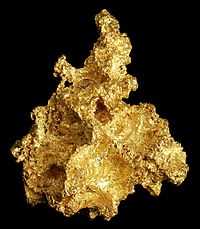
Precious metals are usually rare, chemically relatively inert, and often colorful.
They are transition metals ruthenium (Ru) through silver (Ag) and rhenium (Re) through gold (Au).
Golds
_2_(17025829922).jpg)
"Gold (Au) is the most prestigious metal known, but it's not the most valuable. Gold is the only metal that has a deep, rich, metallic yellow color. Almost all other metals are silvery-colored. Gold is very rare in crustal rocks - it averages about 5 ppb (parts per billion). Where gold has been concentrated, it occurs as wires, dendritic crystals, twisted sheets, octahedral crystals, and variably-shaped nuggets. It most commonly occurs in hydrothermal quartz veins, disseminated in some contact- & hydrothermal-metamorphic rocks, and in placer deposits. Placers are concentrations of heavy minerals in stream gravels or in cracks on bedrock-floored streams. Gold has a high specific gravity (about 19), so it easily accumulates in placer deposits. Its high density allows prospectors to readily collect placer gold by panning."[1]
Platinums

Platinum can also occur as nuggets such as the one imaged on the right from Russia.
Silvers
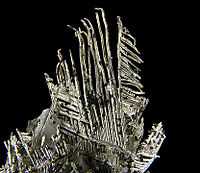
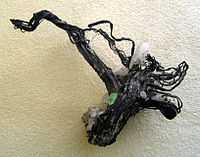
Native silver does occur as cubic, octahedral, or dodecahedral crystals; "also elongated, arborescent, reticulated, or as thin to thick wires."[2]
Iridiums
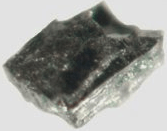
Native iridium such as the small cubic crystal shown in the image on the right is rare.
Osmiums
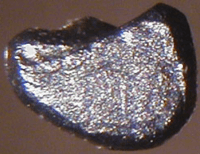
The crystal of native osmium shown on the right is about 2 mm across.
Palladiums

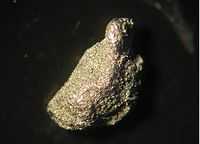
"Natural Palladium [like the nugget shown on the right] always contains some Platinum."[3]
This palladium nugget is from Bom Sucesso Creek, Serro, Minas Gerais, Brazil.
"(Pd,Cu) alloys, some with the approximate composition PdCu4, are reported by Kapsiotis et al. (2010)."[3]
The piece of native palladium [image on the left] from the Mednorudyanskoye Cu Deposit, Nizhnii Tagil, Sverdlovskaya Oblast', Middle Urals, Urals Region, Russia, probably contains some copper.
Potarites
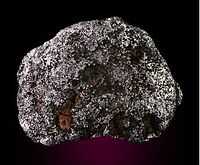
Potarite has the chemical formula PdHg.[2]
On the right is a piece of potarite is from Serro, Minas Gerais, Brazil.
Rheniums

"Native rhenium was first discovered in the Earth's crust in wolframites from a rare metal deposit in the Transbaikal region [1]. [...] The study of the lunar regolith from two sites revealed native rhenium particles with different morphological features: irregular dense particles from Mare Fecunditatis and spheroidal particles from Mare Crisium. The origin of particles (less than 10 µm in size) is assigned to exhalative processes [2]. Among the extraterrestrial objects, native rhenium was found in Ni-iron and silicates from the Allende meteorite [3]."[4]
Rhodiums

The image on the right contains small particles of native rhodium-bearing ferroplatinum. This sample was obtained from the lunar regolith "by the Luna-16 automatic station".[5]
"Terrestrial iron-free rhodium-bearing platinum with the composition of Pt0.68Rh0.32 in association with platinum-bearing rhodium Rh0.57Pt0.43 [...] was originally discovered in heavy fractions from basic rocks (norite, gabbro, and anorthosite) in the upper zone of the layered Stillwater intrusion (Montana, United States) [2]."[5]
Rutheniums
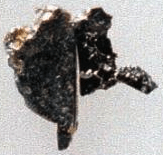
The piece of native ruthenium in the image on the right contains some iridium. It is from Verkhneivinsk, Neiva river, Sverdlovskaya Oblast', Middle Urals, Urals Region, Russia.
Research
Hypothesis:
- Precious metals have variable value so may only be used as an interim investment.
Control groups

The findings demonstrate a statistically systematic change from the status quo or the control group.
“In the design of experiments, treatments [or special properties or characteristics] are applied to [or observed in] experimental units in the treatment group(s).[6] In comparative experiments, members of the complementary group, the control group, receive either no treatment or a standard treatment.[7]"[8]
Proof of concept
Def. a “short and/or incomplete realization of a certain method or idea to demonstrate its feasibility"[9] is called a proof of concept.
Def. evidence that demonstrates that a concept is possible is called proof of concept.
The proof-of-concept structure consists of
- background,
- procedures,
- findings, and
- interpretation.[10]
See also
References
- ↑ James St. John (6 April 2015). "File:Gold nugget (placer gold) 2 (17025829922).jpg, In: Wikimedia Commons". San Francisco, California: Wikimedia Foundation, Inc. Retrieved 2015-07-31.
- 1 2 Willard Lincoln Roberts, George Robert Rapp, Jr., and Julius Weber (1974). Encyclopedia of Minerals. 450 West 33rd Street, New York, New York 10001 USA: Van Nostrand Reinhold Company. pp. 121-2. ISBN 0-442-26820-3.
- 1 2 Hudson Institute of Mineralogy (29 October 2015). "Palladium". Mindat. Retrieved 2015-11-04.
- ↑ A. F. Grachev, S. E. Borisovsky, and A. V. Grigor’eva (October 2008). "The first find of native rhenium in the transitional clay layer at the Cretaceous/Paleogene boundary in the Gams Section (eastern Alps, Austria)". Doklady Earth Sciences 422 (1): 1065-7. doi:10.1134/S1028334X08070131. http://link.springer.com/article/10.1134/S1028334X08070131. Retrieved 2015-11-04.
- 1 2 T. A. Gornostaeva, P. M. Kartashov, A. V. Mokhov, and O. A. Bogatikov (2012). "Native Rhodium-Bearing Ferroplatinum in a Lunar Regolith Sample from the Mare Fecunditatis". Doklady Earth Sciences 444 (2): 770-2. doi:10.1134/S1028334X12060220. http://link.springer.com/article/10.1134/S1028334X12060220#/page-1. Retrieved 2015-11-04.
- ↑ Klaus Hinkelmann, Oscar Kempthorne (2008). Design and Analysis of Experiments, Volume I: Introduction to Experimental Design (2nd ed.). Wiley. ISBN 978-0-471-72756-9. http://books.google.com/?id=T3wWj2kVYZgC&printsec=frontcover.
- ↑ R. A. Bailey (2008). Design of comparative experiments. Cambridge University Press. ISBN 978-0-521-68357-9. http://www.cambridge.org/uk/catalogue/catalogue.asp?isbn=9780521683579.
- ↑ "Treatment and control groups, In: Wikipedia". San Francisco, California: Wikimedia Foundation, Inc. May 18, 2012. Retrieved 2012-05-31.
- ↑ "proof of concept, In: Wiktionary". San Francisco, California: Wikimedia Foundation, Inc. November 10, 2012. Retrieved 2013-01-13.
- ↑ Ginger Lehrman and Ian B Hogue, Sarah Palmer, Cheryl Jennings, Celsa A Spina, Ann Wiegand, Alan L Landay, Robert W Coombs, Douglas D Richman, John W Mellors, John M Coffin, Ronald J Bosch, David M Margolis (August 13, 2005). "Depletion of latent HIV-1 infection in vivo: a proof-of-concept study". Lancet 366 (9485): 549-55. doi:10.1016/S0140-6736(05)67098-5. http://www.ncbi.nlm.nih.gov/pmc/articles/PMC1894952/. Retrieved 2012-05-09.
External links
![]() This is a research project at http://en.wikiversity.org
This is a research project at http://en.wikiversity.org
| |
Educational level: this is a research resource. |
| |
Resource type: this resource is an article. |
| |
Resource type: this resource contains a lecture or lecture notes. |
| |
Subject classification: this is a Geology resource. |